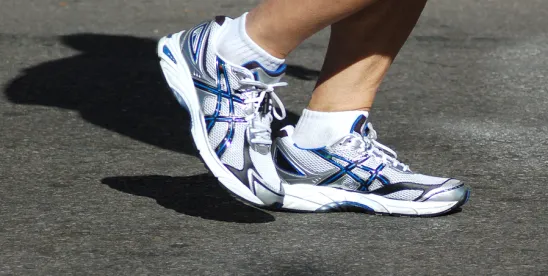Most athletes have probably had a coach or two quote Navy Seal Marcus Luttrell, “You play like you practice and you practice how you play.” But does this always hold true? When considering the top athletes in the world competing at the most elite levels, the answer may be no—at least not with today’s technological advancements. Training technology may allow athletes to perform better in competition, even if such technology is not used or allowed during competition.
With every passing year, athletes push the boundaries of what was previously thought possible. Sydney McLaughlin-Levrone, the reigning Olympic champion in the 400-meter hurdles, recently set a new world record of 50.65 seconds in the event during the 2024 U.S. Track and Field Olympic Trials. Swimmer Katie Ledecky set a world record in the 1500-meter freestyle at the 2021 Tokyo Olympics and was primed to win her fourth gold at the 2024 Paris Olympics, setting yet another record with a time of 15:30.02 minutes.
Although new technology for competition use has contributed to these remarkable achievements, technological advancement in training gear for Olympians and professional athletes has been a key reason why we see these seemingly impossible records made and broken so frequently over the past few decades.
Swimmers, such as Katie Ledecky, strive to have faster strokes than competitors to win races. A common training tool to improve the speed and power of those strokes is a swim parachute, designed to provide resistance while the swimmer maintains proper technique. The swim parachute attaches around the swimmer’s waist, and a canopy portion falls behind the swimmer’s feet to allow for normal swimming. While the athlete swims, the canopy opens to collect water and create resistance. These parachutes are designed for short repetitions, as opposed to long endurance swims, and are best suited for events with straight kicking versus side-to-side kicking [1].
Dry land sports, such as golf, also utilize training gear to increase power. Weighted golf clubs are used to increase consistency and power in a golfer’s swing while also building muscle strength [2]. Certain weighted clubs will distribute the weight differently, as there are head-heavy clubs, evenly distributed clubs, and counterbalanced clubs that hold the extra weight near the club’s grip end. Due to regulations set by governing bodies, these clubs are not permitted for competition use and are only meant to serve as a training tool for golfers.
Training tools like swim parachutes and weighted golf clubs have been utilized for quite a long time and may not seem as high-tech as more recent training technology innovations. Golf simulators, for example, were originally developed in the late 1970s and have evolved significantly in recent years to enable golfers to practice indoors and receive exceptionally detailed swing and ball analysis using an overhead camera and infrared technology.
For many sports, such as track and field, strength conditioning and form correction is a core focus when training to save pivotal milliseconds that can make or break an athlete’s medal position. However, neither coaches nor athletes have been able to tell how intense each specific muscle is working to optimize performance. Smart clothing has emerged as a groundbreaking, innovative way for athletes to analyze their muscle activity to correct form and achieve peak performance [3].
Athos, an athletic clothing company, has created a line of products that provide athletes with muscle-activity-based feedback. One shirt by Athos contains 14 EMG sensors, two heart rate sensors, and two breathing rate sensors that send data to a mobile app that will show users when and where their muscles are firing [4]. Athos smart clothing offers game-changing data to allow an athlete to understand and correct his or her form to shave off those key few milliseconds in their event.
Correct running technique is imperative for all running disciplines, particularly Olympic events, such as the marathon and decathlon. A new shoe sensor, developed through project RUNSAFER by the Biomechanics Institute in Valencia, Spain, is placed on the heel of the shoe and connects to a mobile app to sound a warning to the user if any running anomalies are detected throughout the user’s training session [5].
In more controlled environments, such as treadmill training, the shoe sensor can be used in tandem with reflective markers and infrared sensors to display a detailed visual on a computer interface depicting how the runner moves. This allows athletes to get a full physiological analysis of their form in real time to make immediate adjustments. For races as long and grueling as marathons and decathlons, having consistent proper running form is essential for podium success.
For Olympic cyclists, understanding how much power they use throughout their training is imperative to increasing efficiency and ensuring they are not burning an excessive amount of energy too soon. The Solos Smart Glasses, which are the subject of numerous utility and design patents, aim to offer athletes real-time sensed data so they can increase efficiency in practices leading up to competition. These smart glasses allow the user to visually see real-time changing data, such as power and heart rate, while practicing, via a heads-up display.
Unique advantages of the Solos Smart Glasses include the ability to adjust the heads-up display until it appears sharp for the user, and a connection to the Solos smartphone app to track and compare data between different rides [6]. There are over 16 data variables for the user to choose from when training, allowing coaches to personalize training programs to each specific athlete to optimize the athlete’s performance.
Training technology has undoubtedly improved throughout the years. Now, by leveraging technological advancements in bioanalytic and biomedical sensors, athletes are pushing the boundaries of athletic achievement even further. Although we won’t necessarily see these technologies at the 2024 Olympic Games, keep an eye out for even more broken world records in Paris — the odds are high that innovative training technologies are major contributors to those achievements.
Sources:
[2] https://www.customgolfstop.com/Indoor-Weighted-Iron-Swing-Trainer-p/closeouts012.htm
[4] https://wearables.com/collections/athos/products/athos-shirt
[6] https://velo.outsideonline.com/road/road-racing/reviewed-solos-smart-glasses/





 />i
/>i

